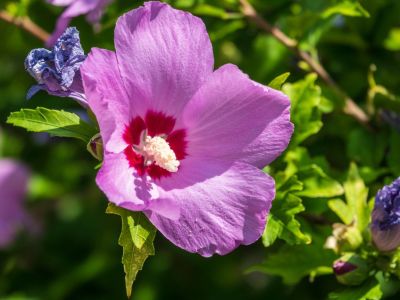The options are vast with varieties ranging from 6-7 feet (1.8-2.1 m.) tall to just 3-4 feet (0.9-1.2 m.) tall at maturity. The oversized flowers feature ruffled petals in all shades of pink, red, magenta, white, and bicolor, some with dark centers or intense veining atop leaves that are green to dark wine purple. If you’re looking to try your hand at growing one of these spectacular plants, let’s look at the 5 things you need to know about growing rose mallow.
1. Hardy in USDA Zones 4-9
Even with its tropical look and feel, this tough perennial is very hardy growing in the North to the Southern states and in between Including the east coast, midwest to northwest. However, this plant can often be confused with its cousin, the tropical hibiscus. When shopping for a rose mallow, be sure to double-check and confirm you are purchasing the right species of hibiscus for the right location.
2. Prefers Moist Soil
While this plant can do well in most types of soil, it prefers soil that is moist or wet. Given the alternative common name of swamp mallow, it is well suited to a moist area on the property where it may be difficult to grow other types of plants. It can even be planted near water features and ponds. For rose mallow to reach its fullest potential for bloom, provide it with full sun, or at least six hours per day.
3. Attracts Unwanted Pests
Some of the most common insect pests are attracted to the foliage and flowers of the rose mallow including aphids, spider mites, thrips, whiteflies and Japanese beetles. The larvae of the sawfly are especially fond of this plant. This army of small green caterpillars will feast on both the upper and lower leaves resulting in lacy foliage.
4. Late to Break Dormancy
Rose mallow is one of the last perennial plants to emerge from the ground in the spring. Some varieties may wait until the beginning of summer to begin growth. Even though they are late to break dormancy, their vigorous growth rate makes up for their late arrival. Cut the plant back to just a few inches above ground in early spring before new growth appears. The stems will be somewhat woody so a strong pair of loppers or even a small pruning saw may be needed.
5. Short-Lived Blooms
The tropical looking flowers of the rose mallow lasts only a day or two, but are quickly replaced by new blooms. If you are tempted to cut a bouquet of these exquisite flowers, don’t. They are not suited for life in a vase. The dinner-plate sized flowers, even though they are short lived, are loved by butterflies and hummingbirds. Plus, they’re often ignored by grazing deer.
Companion Plants
Hardy hibiscus is also friendly with other perennial plants that love sun and moist soil. Mix and match the following plants for spring to fall blooms:
White TurtleheadSwamp MilkweedJapanese IrisMeadowsweetNew England AsterSwitch GrassJoe Pye Weed
